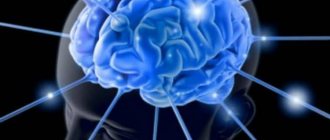Historical facts
Epilepsy has been known since ancient times. According to legend, the famous hero Hercules suffered from it, as did Gaius Julius Caesar. It was believed that a seizure was a visit to a sick person by a deity, and, by external signs, they tried to determine which one. For example, if the patient grinds his teeth, then Hebe is jealous, foam is visible on the lips - the god of war Ares, and so on. There was an interesting custom of interrupting a meeting if one of the participants had an epileptic seizure - it was believed that the gods were thus giving a sign that they were displeased with what was happening. During Christian times, this disease was also considered God's punishment.
The association with higher powers is not accidental here: this disease visited its carrier suddenly and for no apparent reason, dramatically changing his behavior, which was impossible not to notice, so that to a religious person it might seem as if the body of the unfortunate person was being taken over by some otherworldly entities. Since ancient times, doctors have been trying to understand what it really is. For example, Avicenna believed that epilepsy was caused by a mysterious substance - black bile, which comes from the liver to the spleen. If the organ is not working well, then black bile from the liver goes directly to the brain, and in order to prevent this, it creates a spasm - this is how an epileptic seizure occurs.
to contents ^
Causes of the disease
Cryptogenic epilepsy is a form of the disease with subtle or unknown causes. This diagnosis is made in cases where the symptoms of the disease do not fit its other varieties and it is not possible to establish the cause of the disease even after all possible tests. This means that doctors still do not know exactly what cryptogenic epilepsy is and where it comes from.
The occurrence factors are considered to be hereditary predisposition, the consequences of mechanical head injuries, strokes and poisoning with toxic substances. This also includes viral infections, heart, liver or kidney diseases, sudden exposure to bright (especially flashing) light, sharp sound, temperature changes.
Useful to know: Signs of a concussion: symptoms, treatment, consequences
In other forms of this disease, a focus of pathological activity appears in the cerebral cortex, where it should not normally exist. In cryptogenic epilepsy there is no obvious localization.
to contents ^
General information
Cryptogenic (in some sources the definition is idiopathic) epilepsy is a chronic hidden disease of unknown origin.
This disease accounts for about 60% of all cases among people suffering from epileptic seizures. The remaining 40% can be studied. The disease does not matter the patient’s age (it can develop equally in both childhood and adulthood) or gender.
If we talk about the classic type of disease, then a seizure is preceded by the appearance in the brain of a focus of increased neural activity, which actually causes the attack. So, in the case of cryptogenic epilepsy, such foci cannot be detected and that is why the disease is called cryptogenic, which means of unknown origin. Even in ancient times, scientists and doctors wondered what kind of disease this was. In the Middle Ages, it even testified to a person’s obsession and they were sentenced to death by burning or torture.
After the advent of psychiatry, cryptogenic epilepsy finally came out of the shadows and became a full-fledged disease, which began to be intensively studied and tried to treat.
Symptoms and differences from other forms of the disease
The main symptom of epilepsy is the presence of seizures. They come in different types, mainly divided into two groups: generalized and partial.
With focal or cryptogenic epilepsy, partial (partial) seizures are more often observed.
Often the approach of seizures is accompanied by a so-called aura - a symptom signaling their imminent onset. By the appearance of this symptom, one can determine the localization of the lesion in the cerebral cortex. With a motor aura, the patient may move unexpectedly, which means that the affected area is in one of the frontal lobes. For visual or hearing impairments, in the occipital or temporal lobe, respectively. The aura itself is also a partial seizure.
Also, with epilepsy, so-called twilight states may occur, accompanied by visual or auditory hallucinations, erratic motor and speech activity, and confusion. Patients in a twilight state can be very aggressive and even dangerous, try to commit violence against others or themselves, or, on the contrary, try to run away from everyone and hide.
Cryptogenic epilepsy has the following features: more severe attacks, difficulties in selecting effective treatment, and drugs usual for other forms of this disease have a weak effect. There is a rapid regression of the patient's psychomotor and emotional state. If you do an EEG, the changes will be clearly visible, but next time the picture may be shifted. With this form of the disease, one syndrome may clearly manifest itself and other characteristic signs may be absent. However, over time they may or may not appear. As a rule, the syndrome itself cannot be treated or is poorly treatable. For example, with cryptogenic epilepsy, so-called Jacksonian motor seizures can be observed: a person may suddenly take off and run, or his facial expressions undergo continuous chaotic changes.
to contents ^
What types of seizures are there?
If a person has cryptogenic epilepsy, then different types of seizures may occur. Which one a particular person will have directly depends on the area of brain damage . That is why it is difficult to say unambiguously what kind of attack a person will have to face.
It can be noted that if a person has been suffering from epilepsy for a long time, then he is able to predict the occurrence of seizures in advance. This can be done by the aura, which is a harbinger of an attack. Often a person may feel increased anxiety without an obvious reason, which will gradually increase. Panic attacks are also possible; they can also indicate an imminent attack.
In many cases, seizures appear unexpectedly for the patient, and they cannot be stopped. The more severe the disease, the more pronounced its symptoms will be. It is for this reason that it is recommended to consult a doctor in a timely manner so that you can improve your well-being.
It is not uncommon for a person to experience simple partial seizures with cryptogenic epilepsy. In some cases, they can be confused with the usual manifestations of VSD. For example, a person begins to feel chills, tremors in the limbs, nausea and increased blood pressure. To distinguish an epileptic seizure from vegetative-vascular dystonia, you will need to pay attention to the distinctive features.
What is important to consider:
- The seizure lasts no more than 10 minutes.
- Convulsions occur.
- When performing echoencephalography, you can see the presence of an epileptic episode.
- After a short seizure, the patient is unable to concentrate on anything and appears very confused.
Hallucinations may often occur, as well as the inability to navigate in space. Just focusing on symptoms is not enough to make an accurate diagnosis. You will definitely need to undergo an examination, it will allow you to understand exactly what is happening to the person.
Complex seizures cause loss of consciousness and amnesia. The attack lasts up to 5 minutes, while the patient experiences obvious convulsions. In such a situation, it is important to monitor exactly how the seizure progresses. If it drags on and the suffocation does not go away, you should immediately consult a doctor.
It also happens that absence seizure occurs with cryptogenic focal epilepsy. The patient may partially or completely lose consciousness. At the same time, there is an absent expression on the face. It also happens that convulsions occur due to pathology, and it is extremely important to ensure that the person does not bite his tongue and suffocate.
Special focal forms of the disease
Cryptogenic focal epilepsy in young children manifests itself in the form of some characteristic syndromes. West syndrome - occurs between the ages of two and four months; after about a year it can turn into another form of the disease. Convulsions that suddenly begin and also suddenly stop are characteristic.
Lenox-Gastaut syndrome - manifests itself in children from 2 to 8 years old as short-term attacks of imbalance or deafness. There is no loss of consciousness, but such episodes are fraught with trauma. Like the previous form of the disease, they are accompanied by mental retardation.
Useful to know: Brain cyst, its symptoms and treatment
Myoclonic-astatic syndrome - manifests itself from 5 months to a year with generalized seizures, and from the moment the child begins to walk - episodes of loss of balance. Other forms of cryptogenic epilepsy are similar to the classic course of the disease and have the same subtypes.
Types of focal epileptic lesions differ according to the location of the lesion. There is so-called temporal lobe epilepsy, which affects the temporal lobes, which are responsible for behavior, hearing and logical thinking. With frontal lobe epilepsy, speech and cognitive functions are primarily affected. The parietal leads to convulsions and paresis, since this area of the brain cortex is responsible for movement. Occipital epilepsy causes problems with vision and coordination, as well as fatigue.
to contents ^
Treatment of cryptogenic focal epilepsy
The seizures of this disease are completely controllable, with the only exception being frontal lobe epilepsy, which is difficult to treat with anticonvulsants. Drug treatment for focal cryptogenic epilepsy will depend on the causes of the disease that have been investigated and discovered. The main task is not only to stop seizures, but, if possible, to eliminate the basis of the disease.
- Drug therapy . Using this method of treatment, the doctor prescribes medical anticonvulsants to the patient if the patient has more than two seizures per day. As practice has shown, in 25% of all cases this method of treatment has excellent results and leads to a cure for the patient. When the form of the disease is very severe, anticonvulsant drugs help reduce the severity of seizures and their course. Treatment is started with a minimum dose, with further increases. The duration of therapy depends on the severity of the disease and the effectiveness of the drug.
- Surgical intervention . This treatment is used only if it is necessary to remove tumor pathologies from the brain, a cyst, which is the root cause of the development of epilepsy.
- Dieting . The mechanism of action of diet therapy is a clear ratio of fats, carbohydrates and protein in the daily menu. The diet must consist of fatty foods: cream, fatty meats, butter. Reduce such foods as: fruits, pastas, vegetables and baked goods.
Focal cryptogenic epilepsy is not a death sentence, but only a chronic disease. Modern medicine successfully copes with attacks, stopping them with medications. And with timely treatment and the right lifestyle, in 80% of cases, adult patients and sick children can be relieved of the severity of symptoms almost forever.
The goals can be achieved with timely diagnosis and regular use of medications prescribed by doctors. Strictly follow the dosage of medications prescribed by your doctor. Concomitant treatment is the correct daily routine, that is, wisely distributing rest time and stress on the body, the absolute absence of negativity, various shocks and shocks, and a healthy lifestyle. Only in this way, through the efforts of doctors and the patient directly, can one, if not completely cure the disease, then at least reduce its symptoms to a minimum.
Changes in mental functions in epilepsy
As a rule, characteristic changes occur in memory, attention, thinking, speech, personal characteristics, and in general a significant decrease in the rate of mental processes. Already at the initial stage of the disease, there is some inertia in mental activity, for example, it is difficult for the patient to switch attention, which is easy to detect using a switching test, for example, a Schulte table with black and red numbers, where it is necessary to alternately find and name numbers from 1 to 25 in red - descending, black - ascending.
Their thinking can be characterized as sluggish, viscous, and with the increase in epileptic dementia, it becomes difficult to operate with complex logical structures. In speech, “stuckness” on unimportant details is also found, while the goal of verbal communication does not occur. In conversation, such patients tend to use diminutive suffixes: “doctor”, “little bed”, “boy”; they may even seem overly obsequious and sugary, it seems as if they are trying to please. At the same time, the other extreme in the personality of patients with epilepsy is sudden and uncontrollable outbursts of rage, even for minor reasons.
Also, a characteristic feature of these patients is an excessive tendency to order, for example, they can arrange dishes in the closet according to size and perfectly evenly, lay out clothes in the closet by color in perfectly even piles. Their speech is distinguished by a characteristic reasoning, different from schizophrenic: they can talk pathetically or in a moralizing tone for a long time about some shallow, everyday, superficial things. He also suffers, and with pronounced personality changes, there is no sense of humor.
Useful to know: Poor blood circulation in the brain, how to identify the symptoms?
to contents ^
Diagnostics
When diagnosing the disease, the main criterion is to exclude organic brain damage. It is for this purpose that the following procedures are used:
- collection of family and individual anamnesis with clarification of the presence of brain injury, birth or congenital pathology;
- electroencephalogram, based on recording the biorhythms of the brain during various activities, for example, sleep, intellectual or physical activity;
- conducting magnetic resonance imaging, which helps detect impaired brain activity or localized brain damage;
- performing angiography, which allows you to study how well the blood supply to the brain flows;
- neuropsychological diagnostics, designed to study the quality of mental activity;
- a blood serum test aimed at detecting syphilis and other pathogenic microorganisms in the body.
The victim must undergo laboratory tests, including genetic diagnostics, biochemical and general blood tests, as well as a urine test. Epilepsy is diagnosed by doctors only after conducting a full range of examinations and excluding the possibility of other pathologies affecting the body.
The danger of epilepsy
Cryptogenic epilepsy is just as dangerous as its other forms. In addition to the fact that this is a serious disease in itself, causing severe suffering and worsening the quality of life, gradually leading to the degradation of personality and mental functions, it is dangerous due to injuries incompatible with life that the patient can receive during seizures. People diagnosed with epilepsy are prohibited from working at heights, with moving machinery, or near fire and water.
In addition, there is a danger of so-called status epilepticus - when seizures follow one after another and the patient practically does not regain consciousness, or one seizure lasts more than 30 minutes. In this case, emergency medical care is necessary, as there is a risk of developing cerebral edema, pulmonary edema and other dangerous and irreversible complications as a result of hypoxia and death of nerve cells.
to contents ^
Prevention and prognosis
The prognosis is ambiguous, timely diagnosis and correctly selected treatment improve the patient’s well-being and return the previous rhythm of life. Among the complications, the most likely are coma, damage to the limbs during an epileptic seizure, depression of respiratory function, heartbeat, mental and emotional status disorders. When seizures appear in childhood, the process of socialization of the individual suffers; the child either avoids society himself, or society perceives him incorrectly.
Prevention of cryptogenic epilepsy has not been developed.










